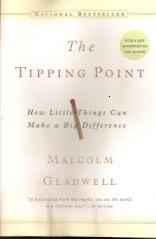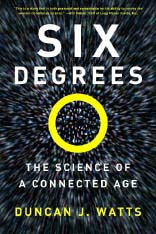Last week, my son Devin Howard (a Grade 12 student, pictured above) won a Gold Medal at Waterloo-Wellington Science and Engineering Fair, enabling him to go on to the Canada-Wide Science Fair, run by Youth Science Foundation, in May at the University of Ottawa.
His topic, for which he developed a computer model written in multi-agent, graphical modelling and simulation language called NetLogo, was to study the propagation of ideas such as fads or partisan political persuasion using some of the latest social graph theories. Last summer, at the acclaimed Shad Valley program at University of Calgary, he became interested in the topic of emergence. For those who are not familiar with this fascinating field, emergence can be defined as as “… the way complex systems and patterns arise out of a multiplicity of relatively simple interactions.”
 From that springboard, he became interested in the way fads and other changes propagate through society, especially illustrated by recent books like Malcolm Gladwell’s The Tipping Point. (An interesting footnote is that Gladwell, now based in New York City, grew up right around the corner in the small community of Elmira). Gladwell, a journalist by trade with a similar modus operandi to Don Tapscott, has done much to popularize a whole new area of science.
From that springboard, he became interested in the way fads and other changes propagate through society, especially illustrated by recent books like Malcolm Gladwell’s The Tipping Point. (An interesting footnote is that Gladwell, now based in New York City, grew up right around the corner in the small community of Elmira). Gladwell, a journalist by trade with a similar modus operandi to Don Tapscott, has done much to popularize a whole new area of science.
Devin’s project aimed to show how fads, political influence, religions and even diseases spread through society. Au courant terms such as tipping, connectors and mavens all arise from this new science which shows how a few key people can take a simple, and seemingly inconsequential idea or trend and turn it into a mass movement. As story-telling narrative it’s intoxicating, as a science it may well be one of the most exciting subject areas of this new century. And, beyond being a very proud father, I was struck by how much the area Devin chose to study sits right in the epicentre of our investment thesis at Verdexus.
 Now, let’s drill a bit deeper to understand why this is so important. Malcolm Gladwell is a (very persuasive) popularizer of complicated and transformational ideas. By contrast, Duncan Watts, associate professor of Sociology at Columbia University and author of the 2003 book Six Degrees, is one of the academic pioneers who managed to fuse existing work in graph theory, psychology, sociology and physics into a new science of connectedness.
Now, let’s drill a bit deeper to understand why this is so important. Malcolm Gladwell is a (very persuasive) popularizer of complicated and transformational ideas. By contrast, Duncan Watts, associate professor of Sociology at Columbia University and author of the 2003 book Six Degrees, is one of the academic pioneers who managed to fuse existing work in graph theory, psychology, sociology and physics into a new science of connectedness.
This new Science of Networks (covering social, biological and technological networks) is truly a post-millennial creation. In an age when we’ve moved beyond mere specialization, whole new research disciplines are synthesized from a set of discrete subject areas. Such fusion of formerly disparate knowlecdge areas is a key example of the Knowledge Integration referred to in Thomas Friedman’s The World is Flat.
I can’t do justice to this field here, but to give a flavour, some key recent breakthroughs are:
- Duncan Watts shows that the connectedness of most social networks isn’t a Nomal Distribution as might be intuitively supposed, but instead is a Scale-Free Network exhibiting a Power-Law Distribution. The significance of this is that a few key Connectors can make (or break) the ability of the network to take over. Watts points to the Matthew Effect in which “well-connected nodes are more likely to attract new links, while poorly connected nodes are disproportionately likely to remain poor.”
- Furthermore, Watts describes Affiliation Networks, or “networks of overlapping cliques”. They are the new social networking version of clubs, but in scientific terms are Bipartite Networks, which are really fused version of networks of Actors and Groups.
- lastly, the concept of Social Currency has really re-defined the notion of brand in this new science.
As I mentioned, I’m just skimming the surface, but the net takeaway that really excites me, is how new some of this fundamental science is. Although the origins of the field may go back 50 or 100 years, many key findings are still a mere 6 or 8 years old. Furthermore, my sense is that this field is just beginning.
To put this into context, I started working with one of the first peer-to-peer, social networked contact systems with Ottawa-based GoodContacts (now acquired by Reunion) back in 2001 and a full 18 months before Plaxo was launched. When later social networks like LinkedIn came along, I remember asking why we hadn’t taken that approach. But, the truth was, that much of the enabling science hadn’t yet been formalized.
With that in mind, in this day of Facebook, Social Branding, Twitter, and the new social conferencing from iotum, I suspect that we are just in an early generation (Beta test?) of the Social Networking Revolution. Therefore, for human interactions with friends, sales, politics, and entertainment, stay tuned for Social 2.0 and beyond. Remember, social networking is not just a fad of college students and teenagers, but a fundamentally different way to optimizing human and social interactions.
9 Apr 2008
0 CommentsScience Fairs, Social Media & Fads – The New Science for the 21st Century
Last week, my son Devin Howard (a Grade 12 student, pictured above) won a Gold Medal at Waterloo-Wellington Science and Engineering Fair, enabling him to go on to the Canada-Wide Science Fair, run by Youth Science Foundation, in May at the University of Ottawa.
His topic, for which he developed a computer model written in multi-agent, graphical modelling and simulation language called NetLogo, was to study the propagation of ideas such as fads or partisan political persuasion using some of the latest social graph theories. Last summer, at the acclaimed Shad Valley program at University of Calgary, he became interested in the topic of emergence. For those who are not familiar with this fascinating field, emergence can be defined as as “… the way complex systems and patterns arise out of a multiplicity of relatively simple interactions.”
Devin’s project aimed to show how fads, political influence, religions and even diseases spread through society. Au courant terms such as tipping, connectors and mavens all arise from this new science which shows how a few key people can take a simple, and seemingly inconsequential idea or trend and turn it into a mass movement. As story-telling narrative it’s intoxicating, as a science it may well be one of the most exciting subject areas of this new century. And, beyond being a very proud father, I was struck by how much the area Devin chose to study sits right in the epicentre of our investment thesis at Verdexus.
This new Science of Networks (covering social, biological and technological networks) is truly a post-millennial creation. In an age when we’ve moved beyond mere specialization, whole new research disciplines are synthesized from a set of discrete subject areas. Such fusion of formerly disparate knowlecdge areas is a key example of the Knowledge Integration referred to in Thomas Friedman’s The World is Flat.
I can’t do justice to this field here, but to give a flavour, some key recent breakthroughs are:
As I mentioned, I’m just skimming the surface, but the net takeaway that really excites me, is how new some of this fundamental science is. Although the origins of the field may go back 50 or 100 years, many key findings are still a mere 6 or 8 years old. Furthermore, my sense is that this field is just beginning.
To put this into context, I started working with one of the first peer-to-peer, social networked contact systems with Ottawa-based GoodContacts (now acquired by Reunion) back in 2001 and a full 18 months before Plaxo was launched. When later social networks like LinkedIn came along, I remember asking why we hadn’t taken that approach. But, the truth was, that much of the enabling science hadn’t yet been formalized.
With that in mind, in this day of Facebook, Social Branding, Twitter, and the new social conferencing from iotum, I suspect that we are just in an early generation (Beta test?) of the Social Networking Revolution. Therefore, for human interactions with friends, sales, politics, and entertainment, stay tuned for Social 2.0 and beyond. Remember, social networking is not just a fad of college students and teenagers, but a fundamentally different way to optimizing human and social interactions.